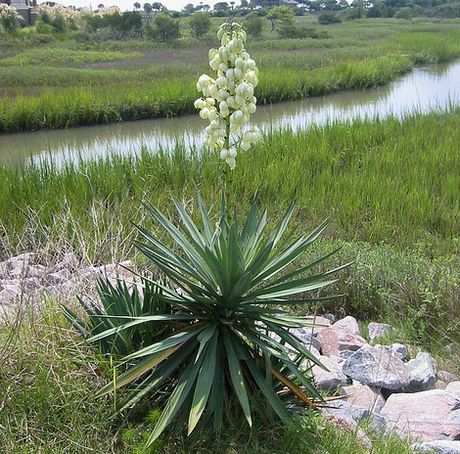Yuccas make a lovely low maintenance screen or garden accent, especially the yucca plant flower. When your yucca plant doesnt bloom, this can be frustrating. But learning more about what yucca plants need to flower can help you feel less frustrated and answer your question, “How do I get my yucca to flower?”
There are more than 40 different kinds of shrubby perennial yucca plants in North America, Mexico, and the Caribbean. They are all in the Agave family. Yuccas are slow growing evergreen plants with sword-like leaves.
All yucca flowers are bell-shaped and sit on top of tall stems. Yuccas are very simple to grow. They can be put in pots or well-drained soil in the ground. Yuccas are drought resistant and can survive for many months without water. They are not picky about sun or shade but do need bright light if indoors.
Check your species to be sure that you are providing the right growing conditions. Not enough light can sometimes discourage blooms on yucca plants.
Regular fertilization and trimming will also help keep the plant healthy and encourage both growth and yucca flowers. You can often get a yucca plant to flower by adding phosphorus-rich fertilizer or bone meal to the soil. The best time to prune yucca plants is in early October.
With their sharp sword-shaped leaves and sculptural shapes, yucca plants make striking landscape specimens. But what really takes them to the next level is the blooms – towering cones or spheres of creamy white flowers. However, yucca plants have a reputation for being somewhat unpredictable and reluctant when it comes to flowering. So how often do these iconic plants actually bloom?
Factors That Influence Yucca Blooming
How regularly a yucca blooms depends on a few key factors
- Species – Some yucca species are far more likely to flower than others. Tree-like forms rarely bloom compared to clumping types.
- Maturity – Most yuccas only bloom once they reach a certain age and size Some can take decades to mature enough to flower
- Climate – Yuccas bloom more readily in warmer climates. Colder zones delay flowering.
- Care – Insufficient sunlight, water, well-drained soil, or nutrients can inhibit flowering.
- Damage – Environmental stresses, pests, or winter damage can prevent yucca blooms.
So when evaluating blooming frequency, the specific type of yucca, its age, growing conditions, and overall health all play a role.
Typical Blooming Frequencies
With the variables above in mind, here are some generalizations for how often you can expect different yucca types to bloom:
- Tree and shrub yucca – Extremely sporadic, often decades between blooms. Unlikely to ever bloom when grown as houseplants or in cold climates. Value for foliage and form rather than flowers.
- Clumping yucca – Bloom every 2-3 years in ideal conditions. Take longer when conditions are less favorable. Individual rosettes die after blooming.
- Common yucca – Young plants may bloom in 2-3 years in peak health. Typically bloom every 3-5 years. More frequent with maturity.
- Soapweed yucca – Extremely slow. May only bloom every 7-10 years even in ideal conditions. Prized for hardiness.
- Hybrids – Various species have been hybridized for more prolific blooms, more color variations, and unique forms. Enhanced blooming over species.
Tips For More Frequent Yucca Blooms
If your heart is set on yucca blooms, choose species and cultivars known for flowering and give them optimal care:
- Select types suitable for your climate. Avoid cold-sensitive species in cooler zones.
- Plant in full sun and provide supplemental lighting for indoor yucca.
- Use fast-draining soil enriched with sand or gravel. Avoid heavy, dense soils.
- Water thoroughly when dry. Soak entire root zone then allow to dry out.
- Fertilize in spring with a balanced fertilizer to encourage blooms.
- Prune judiciously to open up centers and encourage new rosettes.
- Protect from harsh winter conditions that may damage flower buds.
- Allow plants plenty of years to mature. Resist impatience and enjoy the process!
While yucca can be unpredictable bloomers, following these best practices gives you the best shot at enjoying their magnificent blooms on a regular basis. Be sure to choose types inclined to flower and provide optimal care for the magic to happen!
How Do I Get My Yucca to Flower?
If your yucca plant doesnt bloom, it could be due to several things. Yucca plants only bloom when they are fully grown, and each one does it at its own time. Most yucca plants bloom during the warmest part of the growing season, but each species is a little different. Yucca flowers tend to bloom all over the place, so the same yucca may bloom at a different time the next year.
Do not forget to fertilize your yucca and remove the old flower head and stalk from last year to help new flowers grow. The flower of the yucca plant has a unique relationship with a moth that feeds on its nectar and pollinates the flower.
Yucca Plant Care Tips How To Care For Yucca elephantipes
- The Ultimate Guide to Growing Strawberries in Raised Beds - August 8, 2025
- No-Dig Garden Beds: The Easiest Way to Grow a Beautiful Garden - August 6, 2025
- How to Protect and Preserve Wood for Raised Garden Beds - August 6, 2025

